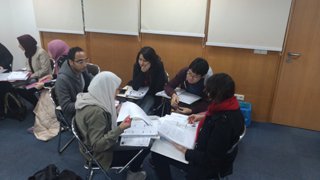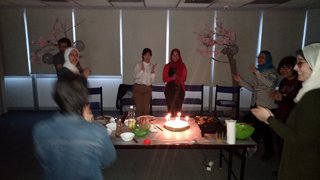Training Course Held in Cairo for Japanese-Language Teachers
The Japan Foundation, Cairo
IIO Koji
Hello everyone. I am IIO Koji, and since January 2017, I have been working as Japanese-Language Chief Advisor at the Japan Foundation, Cairo.
In this report I would like to briefly introduce the Japanese-Language Teacher Training Course that is being conducted by the Japan Foundation, Cairo.
For many years, Cairo University and Ain Shams University in Egypt have been sending out graduates with a high level of Japanese-language ability, but as neither of these universities specializes in Japanese-language education, the Japanese-Language Teacher Training Course is the only one of its kind in Egypt.
The Japan Foundation, Cairo launched the Japanese-Language Teacher Training Course in 2001, and although there was a period when its operation was temporarily put on hold, to date more than 100 people have completed the course. When the course first started, most of the students were Japanese people, but today most are Egyptian. Thanks to its many years of good results and an excellent reputation it is extremely popular, and this fiscal year 21 people applied to join, a vast increase on the 10 people who took the course in the previous fiscal year. A diverse range of people take the course, including current teachers at Cairo University and Ain Shams University and those who are planning to become language assistants, as well as students with no teaching experience who have just graduated from a Japanese-language degree course, and also Japanese people living locally. The current course is split into two parts, with about three months spent learning theory, after which the class is split into two groups that then spends just under two months each putting the theory into practice in actual lessons.
In terms of people’s career paths after taking the course, it used to be the case that many people would teach Japanese-language course at the Japan Foundation, Cairo. However, following the announcement of the Egypt-Japan Education Partnership (EJEP) and the subsequent rush to newly establish Japanese departments at universities in Egypt, more and more people who complete the course are now going on to teach at universities with newly established Japanese departments. It is also anticipated that cases will continue to increase of Egyptian teachers not just remaining in Egypt, but going to teach Japanese in Middle Eastern countries where there are shortages of Japanese teachers, including Saudi Arabia, Qatar and the UAE. As this general trend is expected to continue for the foreseeable future I am doing my best to further enhance the course.
I am also currently making preparations to somehow make it possible for the class to be held online, in order to welcome people who are unable to commute each week to Cairo. This includes Japanese-language teachers living in regional cities like Alexandria and Aswan, and also those who are working in other countries in the Middle East or North Africa. In particular, for the Japanese teachers in countries like Iraq, Syria and Yemen, whose passion for Japanese-language education has not dimmed even in the midst of conflict, I would like to somehow provide opportunities for them to brush up their teaching methods.
The goal of the course is to help teachers “Break away from the classes I’ve taken, the textbooks I’ve used, and the lessons I’ve done.” Although there is nothing wrong with the classes that they have taken or the textbooks they have used to date, through this course I hope that they will be introduced to new ideas and teaching methods, which will encourage them to question their own beliefs and to reconstruct new ones. If they can do this then I believe that the direction they need to aim for will become clear and they will be able to take classes with confidence, which in turn will give them an even greater sense of fulfilment at having become a Japanese-language teacher.

Scene from a class
I would like to end this report by introducing part of a student’s report on their experiences of the course, which was submitted after completion. This report wasn’t something that I had requested, but the student wrote it themselves and inserted it into the portfolio. The student hasn’t yet had any experience of teaching Japanese, but I was overjoyed to read that they have been able to visualize their own image of an ideal teacher so concretely, which at the same time made me truly happy to have come to Egypt. It was not only this student—many of the portfolios submitted after the course were far more impressive than I had ever expected, and I was able to see and feel the growth of the students. Encouraged by this outcome, I would like to continue to make my own contribution to the development of Japanese-language education in the Middle East and North Africa.
Excerpt from student report on the course.
“Before the course, I thought that I would be a strict teacher. Now, I find myself wanting to be a forward-looking teacher who can learn together with my students and enjoy classes with them, all the while appreciating the beauty of the Japanese language and culture, and also be influenced by my learners while influencing them, making them smile, and encouraging them to grow without fear of failure. I want to hold classes that learners enjoy and do not want to end. The ideal class is one where both teachers and learners learn something new each time. I will continue to make efforts so that I can become just such a teacher and hold such classes.”

Farewell party for previous Japanese-Language Specialist Ms. Sakemi
- What We Do Top
- Arts and Cultural Exchange [Culture]
- Japanese-Language Education Overseas [Language]
- Japanese-Language Education Overseas [Language] Top
- Learn Japanese-language
- Teach Japanese-language
- Take Japanese-Language Test
- Know about Japanese-language education abroad
- The Japanese-Language Institute, Urawa
- The Japanese-Language Institute, Kansai
- Japanese-Language Programs for Foreign Specified Skilled Worker Candidates
- Japanese Language Education for Japanese Children Resident Overseas and for the Descendants of Migrants
- Archives
- Japanese Studies and Global Partnerships [Dialogue]
- JF digital collection
- Other Programs / Programs to Commemorate Exchange Year
- Awards and Prizes
- Publications
